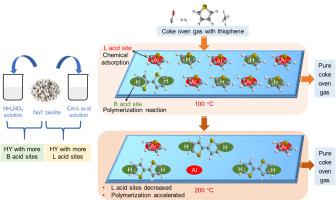当前位置:
X-MOL 学术
›
Fuel Process. Technol.
›
论文详情
Our official English website, www.x-mol.net, welcomes your feedback! (Note: you will need to create a separate account there.)
Ultra-deep removal of thiophene in coke oven gas over Y zeolite: Effect of acid modification on adsorption desulfurization
Fuel Processing Technology ( IF 7.5 ) Pub Date : 2021-03-01 , DOI: 10.1016/j.fuproc.2020.106632 Fanjing Wei , Xiaoqin Guo , Junjie Liao , Weiren Bao , Liping Chang
Fuel Processing Technology ( IF 7.5 ) Pub Date : 2021-03-01 , DOI: 10.1016/j.fuproc.2020.106632 Fanjing Wei , Xiaoqin Guo , Junjie Liao , Weiren Bao , Liping Chang

|
Abstract The ultra-deep removal of thiophene to 0.1 ppmv level is necessary for coke oven gas to methane process. NaY zeolite was reported to have this potential, and acid sites in NaY play an important role on its desulfurization performance. Based on this situation, sorbents with different types and strengths of acids were prepared by modifying NaY in ammonium nitrate and citric acid solutions. Their desulfurization behaviors in simulated coke oven gas were evaluated by fixed bed. The results show that both ammonium nitrate and citric acid modification on NaY are beneficial to the breakthrough adsorption capacity of thiophene (Qb-thiophene). The NaY after modified in 0.10 mol/L citric acid solution has the highest Qb-thiophene at 100 °C. Ammonium nitrate modification could significantly increase medium-strong Bronsted acid in NaY, whereas citric acid modification mainly increases weak Lewis acid. On medium-strong Bronsted acid sites, thiophene polymerization reaction would occur easily, which would result in the obvious decrease of Qb-thiophene from 71.31 to 35.3 mg/g due to the acid sites covering and micropores blocking by thiophene oligomer. The increase of Lewis acid is conducive to desulfurization. Moreover, on Lewis acid site, the temperature region for thiophene removal is wider than that on Bronsted acid.
中文翻译:

Y型沸石超深度去除焦炉煤气中的噻吩:酸改性对吸附脱硫的影响
摘要 焦炉煤气制甲烷工艺需要将噻吩超深度去除至 0.1 ppmv 水平。据报道,NaY 沸石具有这种潜力,NaY 中的酸位对其脱硫性能起着重要作用。基于这种情况,通过对硝酸铵和柠檬酸溶液中的 NaY 进行改性,制备了具有不同类型和强度的酸吸附剂。用固定床评价了它们在模拟焦炉煤气中的脱硫行为。结果表明,硝酸铵和柠檬酸对NaY的改性都有利于噻吩(Qb-噻吩)的突破吸附能力。在 0.10 mol/L 柠檬酸溶液中改性后的 NaY 在 100 °C 时具有最高的 Qb-噻吩。硝酸铵改性可显着增加 NaY 中的中强布朗斯台德酸,而柠檬酸改性主要增加弱路易斯酸。在中等强的布朗斯台德酸位点上,容易发生噻吩聚合反应,由于噻吩低聚物的酸性位点覆盖和微孔堵塞,导致Qb-噻吩从71.31mg/g明显下降到35.3mg/g。路易斯酸的增加有利于脱硫。此外,在路易斯酸位点上,噻吩去除的温度范围比布朗斯台德酸位点宽。
更新日期:2021-03-01
中文翻译:

Y型沸石超深度去除焦炉煤气中的噻吩:酸改性对吸附脱硫的影响
摘要 焦炉煤气制甲烷工艺需要将噻吩超深度去除至 0.1 ppmv 水平。据报道,NaY 沸石具有这种潜力,NaY 中的酸位对其脱硫性能起着重要作用。基于这种情况,通过对硝酸铵和柠檬酸溶液中的 NaY 进行改性,制备了具有不同类型和强度的酸吸附剂。用固定床评价了它们在模拟焦炉煤气中的脱硫行为。结果表明,硝酸铵和柠檬酸对NaY的改性都有利于噻吩(Qb-噻吩)的突破吸附能力。在 0.10 mol/L 柠檬酸溶液中改性后的 NaY 在 100 °C 时具有最高的 Qb-噻吩。硝酸铵改性可显着增加 NaY 中的中强布朗斯台德酸,而柠檬酸改性主要增加弱路易斯酸。在中等强的布朗斯台德酸位点上,容易发生噻吩聚合反应,由于噻吩低聚物的酸性位点覆盖和微孔堵塞,导致Qb-噻吩从71.31mg/g明显下降到35.3mg/g。路易斯酸的增加有利于脱硫。此外,在路易斯酸位点上,噻吩去除的温度范围比布朗斯台德酸位点宽。

























 京公网安备 11010802027423号
京公网安备 11010802027423号